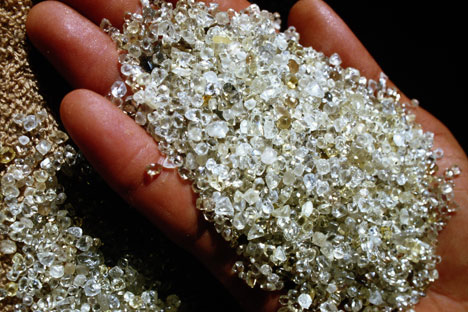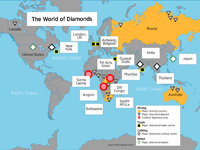Asteroid crater in Eastern Siberia contains huge quantity of diamonds

It was widely believed that impact diamonds are not suitable for industrial use. Source: GettyImages/Fotobank
The 1970s discovery of a deposit of super-hard diamonds or impact diamonds, located in an asteroid crater between Krasnoyarsk Territory and the Republic of Yakutia in Russia’s Eastern Siberian region has finally been declassified. The deposit, known as the Popigai Astroblem, was discovered almost 4 decades ago, but Soviet scientists decided to keep the find secret. Renowned geologist Alexander Portnov was of the opinion that the discovery should be kept und wraps since the scientific community did not know the best way to make use of the diamonds.
It was widely believed that impact diamonds are not suitable for industrial use because of their unpredictable and non-standard characteristics. Today, however, experts agree that the unique properties of these diamonds make them suitable for use in high-tech optics and electronics.
“Research into impact diamonds had been classified for a very long time, because the reserves are immense, but (Soviet) scientists did not believe they could be used in industry. The very possibility of their application in the manufacturing sector is a sensation,” said Portnov.
Industrial use of diamonds is very high, amounting to approximately 5 billion carats, but most of these diamonds are produced artificially, said Sergei Goryainov, an observer at the Rough&Polished diamond information and analysis agency.
“Industrial diamonds have multiple applications, but successful crystal synthesis experiments have resulted in appearance of numerous synthetic diamonds with tailor-made properties. When you extract natural diamonds, you can never be sure about the exact properties. The share of natural diamonds on the market for industrial crystals has been shrinking for a long time now, and is currently quite insignificant,” Goryainov said.
Despite the overall industry preference for synthetic diamonds, a few big corporations have expressed an interest in the rediscovered deposit, said Nikolai Pokhilenko, director of the Novosibirsk Institute of Geology and Mineralogy.
“They have peculiar properties. They are harder, much harder than the ordinary diamonds we all know. They can revolutionise the tool-making industry, drilling, processing of solid substances, because it is the hardest natural material known to us. They can be applied in high-tech industries: electronics, optics, production of high-precision lenses. We see excellent prospects and some big corporations, such as De Beers and some Chinese companies, have already shown an interest,” Pokhilenko said.
Scientists believe that the declassified Popigai Astroblem has enough diamond reserves to meet for the entire world’s demand for the next 3,000 years, basically trillions of carats of diamonds.
First published in Russian in Kommersant Daily.
All rights reserved by Rossiyskaya Gazeta.
Subscribe
to our newsletter!
Get the week's best stories straight to your inbox
